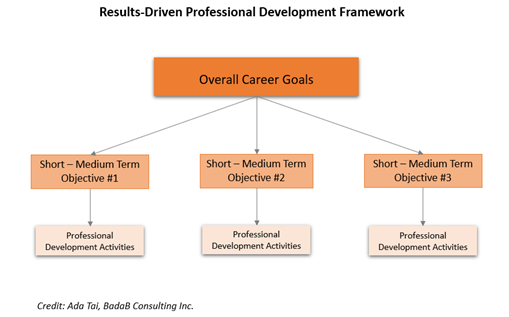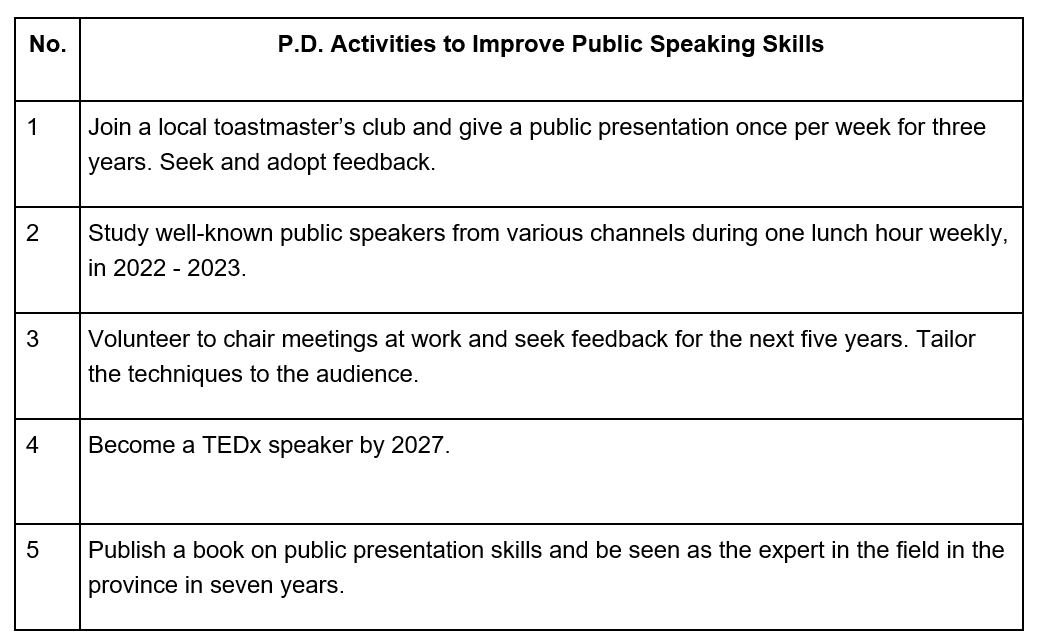
What Is Your Professional Development Plan?

Author: Ada Tai, MBA, CPHR, SHRM-SCP
When hearing the term “Professional Development” (P.D.), we often think about taking classes, participating in projects, joining professional associations, reading books, etc. Undoubtedly, these are good methods to keep our knowledge and skills up-to-date; however, how have the results of these P.D. activities improved your personal and career growth?
In my earlier blog, “ Will You Work for Free, ” I laid out four practical ways to improve our learning, such as:
- Self-directed studying
- Applying the new knowledge practically
- Sharing what we know with others
- Reflecting and self-evaluating
Completing P.D. activities without having a clear plan is like driving a car without knowing where we are going. Effective P.D. needs to satisfy three conditions:
1. Effective P.D. activities need to align with our career goals.
I recently met a hard-working, intelligent and introverted professional, Remy, at a growing organization during a succession planning project that I was working on. After enjoying conversations about career goals, he identified his long-term career goal as to become an executive of the corporation he is currently at in 10 years.

As our conversation evolved, I learned that Remy’s advantages are his exceptional writing, project planning and problem solving skills. However, he knows that he needs to overcome several challenges to acquire the role he desires. One of them is his biggest weakness: speaking in front of a crowd. Once the overall career direction is defined, effort should be put towards exploring the suitable methods to achieve those objectives. Therefore, to accomplish Remy’s career goal, we created a P.D. plan for each of his objectives. Below is an example of one area of focus:

2. Complete the P.D. activities with the right mindset.
We often include various P.D. activities as part of the yearly goal-setting process. Working in HR, unfortunately, I have seen too many professionals writing out (and completing) their P.D. goals to satisfy the work requirement instead of fulfilling their own growth needs. In this case, Remy realizes that he needs to dedicate time, resources and energy to accomplish the identified activities. For many people, the most challenging part is to sustain continuous passion. However, a driven mindset is developed when we know that the P.D. activities are aligned with our career goals and can eventually help us reach our dreams.
3. Continuous environmental scanning to understand what is needed for our field of occupation.
Although creating a P.D. plan is essential, adapting the plan to suit the needs of tomorrow is more critical. The knowledge and skills needed today may be obsolete in years to come.
As working professionals, our time is limited and precious. To achieve the greatest return on our P.D. investment, we need a thoughtful plan and a proactive attitude. Too often, abstract planning and calculation fail to translate into real action. If our plans are realistic and useful, acting upon them will not only be easier and more efficient; it will also allow us to transform aspirations into achievements.
I see. I hear. I experience . is a column created by and written by Ada Tai, a chartered member of CPHR Alberta. The column is written in a blog format where Ada and invited co-authors will present their own experiences and interpretations of the world of human resources and its impact on business management. This and the subsequent posts are copyrighted materials by the author(s) and only reflect their personal views, not CPHR Alberta’s.
Author bio: With an MBA Degree, a CPHR, and an SHRM-SCP designation, Ada Tai has been working as an HR professional in a variety of industries for over a decade. Through her consulting firm, Ada and the team provide a variety of strategic and pragmatic management consulting services. Ada’s public speaking skills have enabled her to be regularly invited to speak about HR, people management, career search, and networking topics throughout the province. She is also a well-respected Instructor at the University of Alberta and MacEwan University.
Contact information:
● Website: www.badab101.com
● LinkedIn: adatai or BadaB-Consulting-Inc
● Facebook: badabconsulting
BadaB Consulting Inc. provides a wide range of human resources solutions, including Strategic HR and Succession Planning, Organizational Design & Development, Diversity & Inclusion Program, Merger & Acquisition Support, Recruitment, Skills Development Training, Compensation Design, Performance Management, Workplace Investigation, Policy Development, etc. Another specialty of BadaB’s services is a personal job search and career coaching. The team has effectively helped over 500 people to find work.
The views and opinions expressed in this blog post belong solely to the original author(s) and do not necessarily represent the views and opinions of CPHR Alberta.
The views and opinions expressed in this blog post belong solely to the original author(s) and do not necessarily represent the views and opinions of CPHR Alberta.





